Monitoring of Ultra-High Dose Rate Pulsed X-ray Facilities with Radioluminescent Nitrogen-Doped Optical Fiber
Abstract
:1. Introduction
2. Materials and Methods
2.1. Facilities Description
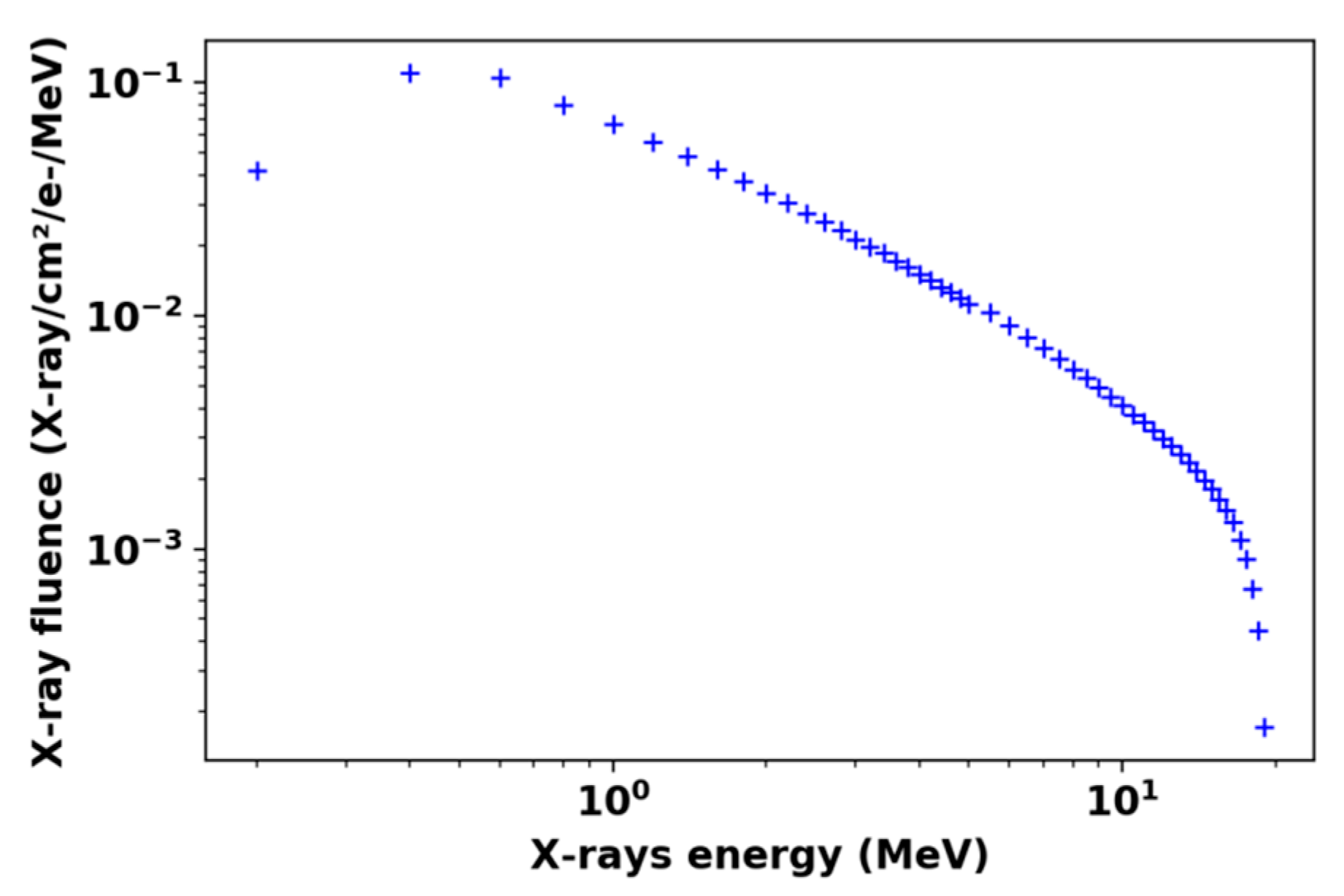
2.2. Sample Description
2.3. RIE Experimental Setup
2.4. Experimental Procedure
2.5. Calibration of the Nitrogen-Doped Optical Fiber Dosimeter
3. Results
3.1. LabHX Steady-State X-ray Irradiation
3.2. ELSA Microsecond-Scale Flash Monitoring
3.3. Asterix Nanosecond Scale Flash Monitoring
4. Discussion
5. Conclusions
Author Contributions
Funding
Institutional Review Board Statement
Informed Consent Statement
Data Availability Statement
Acknowledgments
Conflicts of Interest
References
- Kinhikar, P.A.; Sharma, P.K.; Tambe, C.M.; Deshpande, D.D. Dosimetric evaluation of a new OneDose MOSFET for Ir-192 energy. Phys. Med. Biol. 2006, 51, 1261–1268. [Google Scholar] [CrossRef] [PubMed]
- Duzellier, S. Radiation effects on electronic devices in space. Aerosp. Sci. Technol. 2005, 9, 93–99. [Google Scholar] [CrossRef]
- Dias, H.; Lefesvre, I.; Le Coeur, D. Radiation effects on spatial dark current fluctuations in charge coupled devices (CCD) image sensors. SPIE Space Opt. 1994, 2210, 466–473. [Google Scholar] [CrossRef]
- Lin, B.; Gao, F.; Yang, Y.; Wu, D.; Zhang, Y.; Feng, G.; Dai, T.; Du, X. FLASH Radiotherapy: History and Future. Front. Oncol. 2021, 11, 1890. [Google Scholar] [CrossRef] [PubMed]
- Hughes, J.R.; Parsons, J.L. FLASH Radiotherapy: Current Knowledge and Future Insights Using Proton-Beam Therapy. Int. J. Mol. Sci. 2020, 21, 6492. [Google Scholar] [CrossRef]
- D’Avino, V.; Caruso, M.; Arrichiello, C.; Ametrano, G.; La Verde, G. Thermoluminescent dosimeters (TLDs-100) calibration for dose verification in photon and proton radiation therapy. Il Nuovo Cim. 2020, 43, 142. [Google Scholar] [CrossRef]
- Sathish Kumar, A.; Sharma, S.D.; Paul Ravindran, B. Characteristics of mobile MOSFET dosimetry system for megavoltage photon beams. J. Med. Phys. 2014, 39, 142–149. [Google Scholar] [CrossRef]
- Kulhar, M.; Dhoot, K.; Pandya, A. Gamma Dose Rate Measurement Using RadFET. IEEE Trans. Nucl. Sci. 2019, 66, 2220–2228. [Google Scholar] [CrossRef]
- Beaulieu, L.; Goulet, M.; Archambault, L.; Beddar, S. Current status of scintillation dosimetry for megavoltage beams. J. Phys. Conf. Ser. IC3DDose 2013, 444, 012013. [Google Scholar] [CrossRef]
- Bourgade, J.L.; Marmoret, R.; Darbon, S.; Rosch, R.; Troussel, P.; Villette, B.; Glebov, V.; Shmayda, W.; Gommé, J.C.; Le Tonqueze, Y.; et al. Diagnostics hardening for harsh environment in Laser Mégajoule. Rev. Sci. Instrum. 2008, 79, 10F301. [Google Scholar] [CrossRef]
- Alharbi, M.; Martyn, M.; Chen, L.; Gillespie, S.; Woulfe, P.; O’Keeffe, S.; Foley, M. Novel optical fibre sensors and their applications in radiotherapy. In Proceedings of the Optical Sensing and Detection V, Strasbourg, France, 9 May 2018; SPIE: Bellingham, WA, USA, 2018; Volume 10680. [Google Scholar] [CrossRef]
- Tomashuk, A.L.; Grekov, M.V.; Vasiliev, S.A.; Svetukhin, V.V. Fiber-optic dosimeter based on radiation-induced attenuation in P-doped fiber: Suppression of post-irradiation fading by using two working wavelengths in visible range. Opt. Express 2014, 22, 16778–16783. [Google Scholar] [CrossRef] [PubMed]
- Söderström, D.; Kettunen, H.; Morana, A.; Javanainen, A.; Ouerdane, Y.; El Hamzaoui, H.; Capoen, B.; Bouwmans, G.; Bouazaoui, M. Radioluminescence Response of Ce-, Cu- and Gd-Doped Silica Glasses for Dosimetry of Pulsed Electron Beams. Sensors 2021, 21, 7523. [Google Scholar] [CrossRef] [PubMed]
- Cieslikiewicz-Bouet, M.; El Hamzaoui, H.; Ouerdane, Y.; Mahiou, R.; Chadeyron, G.; Bigot, L.; Delplace-Baudelle, K.; Habert, R.; Plus, S.; Cassez, A.; et al. Investigation of the Incorporation of Cerium Ions in MCVD-Silica Glass Preforms for Remote Optical Fiber Radiation Dosimetry. Sensors 2021, 21, 3362. [Google Scholar] [CrossRef] [PubMed]
- Vidalot, J.; Morana, A.; El Hamzaoui, H.; Boukenter, A.; Bouwmans, G.; Cassez, A.; Capoen, B.; Ouerdane, Y.; Gaillardin, M.; Bouazaoui, M.; et al. Optical Fiber-Based Monitoring of X-ray Pulse Series from a Linear Accelerator. Radiation 2022, 2, 17–32. [Google Scholar] [CrossRef]
- Girard, S.; Kuhnhenn, J.; Gusarov, A.; Brichard, B.; Van Uffelen, M.; Ouerdane, Y.; Boukenter, A.; Marcandella, C. Radiation Effects on Silica-Based Optical Fibers: Recent Advances and Future Challenges. IEEE Trans. Nucl. Sci. 2013, 60, 2013. [Google Scholar] [CrossRef]
- Girard, S.; Alessi, A.; Richard, N.; Martin-Samos, L.; De Michele, V.; Giacomazzi, L.; Agnello, S.; Di Francesca, D.; Morana, A.; Winkler, B.; et al. Overview of radiation induced point defects in silica-based optical fibers. Rev. Phys. 2019, 4, 100032. [Google Scholar] [CrossRef]
- Campanella, C.; De Michele, V.; Morana, A.; Guttilla, A.; Mady, F.; Benabdesselam, M.; Marin, E.; Boukenter, A.; Ouerdane, Y.; Girard, S. Temperature Dependence of Radiation Induced Attenuation of Aluminosilicate Optical Fiber. IEEE Trans. Nucl. Sci. 2022; accepted for publication. [Google Scholar] [CrossRef]
- Girard, S.; Ouerdane, Y.; Marcandella, C.; Boukenter, A.; Quenard, S.; Authier, N. Feasability of radiation dosimetry with phosphorus-doped optical fibers in the ultraviolet and visible domain. J. Non-Cryst. Solids 2011, 357, 1871–1874. [Google Scholar] [CrossRef]
- Francesca, D.D.; Vecchi, G.L.; Girard, S.; Morana, A.; Reghioua, I.; Alessi, A.; Hoehr, C.; Robin, T.; Kadi, Y.; Brugger, M. Qualification and Calibration of Single-Mode Phosphosilicate Optical Fiber for Dosimetry at CERN. J. Lightwave Technol. 2019, 37, 4643–4649. [Google Scholar] [CrossRef]
- Tamm, I.E. General Characteristics of Vavilov-Cherenkov Radiation. Science 1960, 131, 206–210. [Google Scholar] [CrossRef]
- Hoehr, C.; Morana, A.; Duhamel, O.; Capoen, B.; Trinczek, M.; Paillet, P.; Duzenli, C.; Bouazaoui, M.; Bouwmans, G.; Cassez, A.; et al. Novel Gd 3+ -doped silica-based optical fiber material for dosimetry in proton therapy. Sci. Rep. 2019, 9, 16376. [Google Scholar] [CrossRef] [PubMed]
- Mones, E.; Veronese, I.; Moretti, F.; Fasoli, M.; Loi, G.; Negri, E.; Brambilla, M.; Chiodini, N.; Brambilla, G.; Vedda, A. Feasability study for the use of Ce3+-doped optical fibres in radiotherapy. Nucl. Instrum. Methods Phys. Res. Sect. A 2006, 562, 449–455. [Google Scholar] [CrossRef]
- Veronese, I.; Cantone, M.C.; Chiodini, N.; Coray, A.; Fasoli, M.; Lomax, A.; Mones, E.; Moretti, F.; Vedda, A. Feasability study for the use of cerium-doped silica fibres in proton therapy. Radiat. Meas. 2010, 45, 635–639. [Google Scholar] [CrossRef]
- Girard, S.; Di Francesca, D.; Morana, A.; Hoehr, C.; Paillet, P.; Duzenli, C.; Kerboub, N.; Reghioua, I.; Li Vecchi, G.; Alessi, A.; et al. X-rays, γ-rays and Proton Beam Monitoring with Multimode Nitrogen-doped Optical Fiber. IEEE Trans. Nucl. Sci. 2019, 66, 306–311. [Google Scholar] [CrossRef]
- Werner, C.J.; Bull, J.S.; Solomon, C.J.; Brown, F.B.; McKinney, G.W.; Rising, M.E.; Dixon, D.A.; Martz, R.L.; Hughes, H.G.; Cox, L.J.; et al. MCNP Version 6.2 Release Notes; OSTI, No. 1419730; Los Alamos National Lab. (LANL): Los Alamos, NM, USA, 2018. [Google Scholar] [CrossRef]
- Raboisson, G.; Eyl, P.; Roche, M.; Malaval, C.; Johan, A. Asterix, a high intensity x-ray generator. In Proceedings of the 7th Pulsed Power Conference, Monterey, CA, USA, 11–14 June 1989; pp. 567–570. [Google Scholar] [CrossRef]
- Johan, A. ASTERIX a new facility for simulation of dose rate effects on electronics. Ann. Phys. 1989, 14, 379–394. [Google Scholar]
- Richard, N.; Girard, S.; Giacomazzi, L.; Martin-Samos, L.; Di Francesca, D.; Marcandella, C.; Alessi, A.; Paillet, P.; Agnello, S.; Boukenter, A.; et al. Coupled theoretical and experimental studies for the radiation hardening of silica-based optical fibers. IEEE Trans. Nucl. Sci. 2014, 61, 1819–1825. [Google Scholar] [CrossRef]
- Di Francesca, D. Roles of Dopants, Interstitial O2 and Temperature in the Effects of Irradiation on Silica-Based Optical Fibers. Ph.D. Dissertation, University of Saint-Étienne, Saint-Etienne, France, 2015. [Google Scholar]
- Dianov, E.M.; Golant, K.M.; Khrapko, R.R.; Tomashuk, A.L. Low-loss nitrogen-doped silica fibers: The prospects for applications in radiation environments. In Proceedings of the Optical Fiber Communications, OFC, San Jose, CA, USA, 25 February 1996; pp. 61–62. [Google Scholar] [CrossRef]
- Reghioua, I. Cathodoluminescence Characterization of Point Defects in Silica-Based Materials: Optical Fibers and Nanoparticles. Ph.D. Thesis, Université de Lyon, Lyon, France, 2018. [Google Scholar]
- Meyer, A.; Morana, A.; El Hamzaoui, H.; Capoen, B.; Bouwmans, G.; Bouazaoui, M.; Girard, S.; Marin, E.; Ouerdane, Y.; Boukenter, A. X-ray Radioluminescence in Diversely Doped Multimode Silica-based Optical Fibers. IEEE Trans. Nucl. Sci. 2022; accepted for publication. [Google Scholar] [CrossRef]
- Veronese, I.; Cantone, M.C.; Catalano, M.; Chiodini, N.; Fasoli, M.; Mancosu, P.; Mones, E.; Moretti, F.; Scorsetti, M.; Vedda, A. Study of the radioluminescence spectra of doped silica optical fibre dosimeters for stem effect removal. J. Phys. D Appl. Phys. 2013, 66, 015101. [Google Scholar] [CrossRef]
- Hamamatsu. Photon Counting Head: H7421-40. Available online: https://www.hamamatsu.com/eu/en/product/optical-sensors/pmt/pmt-module/photon-counting-head/H7421-40.html (accessed on 30 March 2022).
- Hamamatsu. Counting Unit: C8855-01. Available online: https://www.hamamatsu.com/eu/en/product/optical-sensors/pmt/accessory-for-pmt/counting-unit/C8855-01.html (accessed on 30 March 2022).
- Moretti, F.; Patton, G.; Belshy, A.; Petrosyan, A.G.; Dujardin, C. Deep traps can reduce memory effects of shallower ones in scintillators. Phys. Chem. Phys. 2006, 18, 1178–1184. [Google Scholar] [CrossRef]
- Girard, S.; Griscom, D.; Baggio, J.; Brichard, B.; Bergmans, F. Transient optical absorption in pulsed X-ray-irradiated pure-silica-core optical fibers: Influence of self-trapped hole. J. Non-Cryst. Solids 2006, 352, 2637–2642. [Google Scholar] [CrossRef]
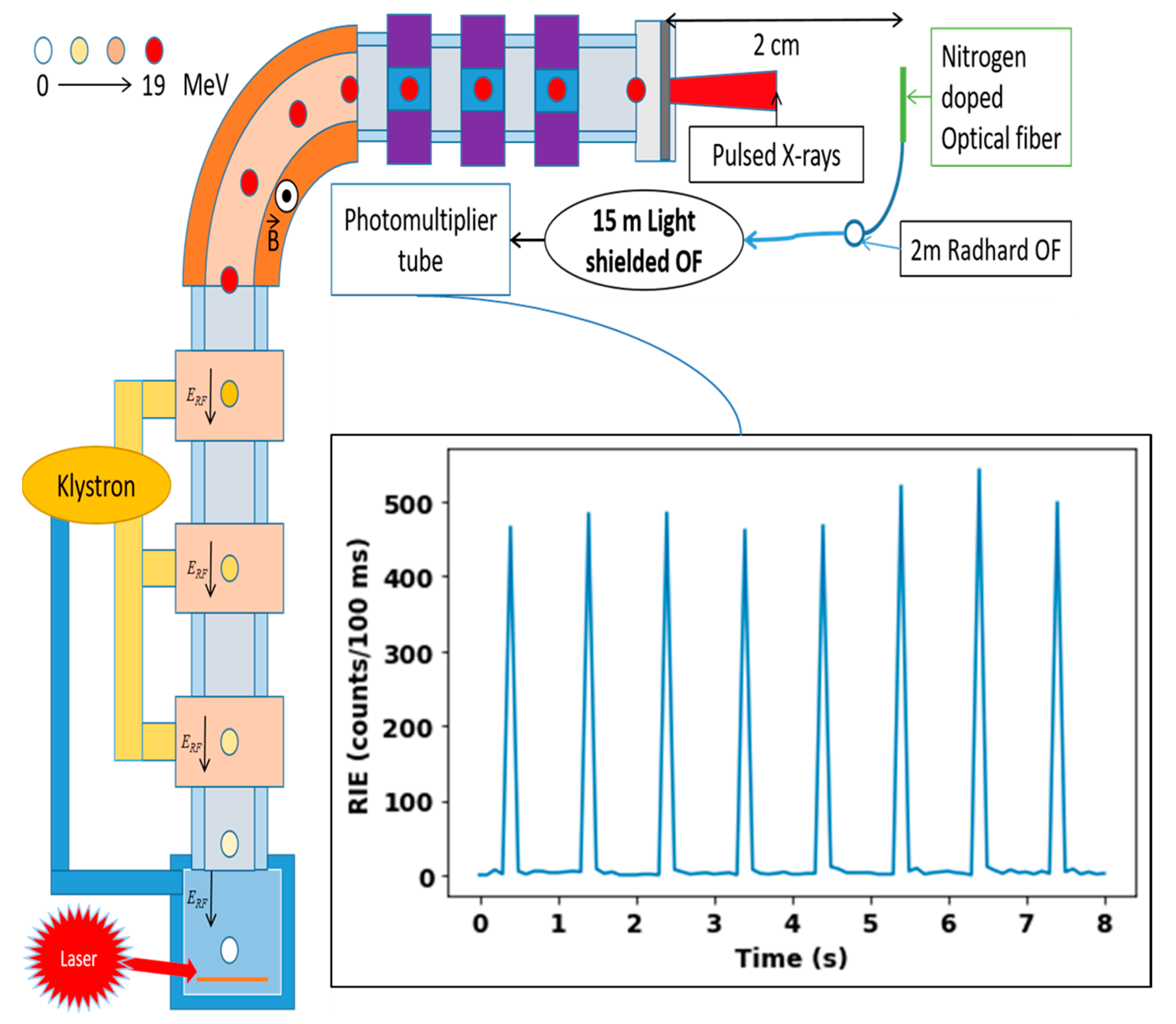
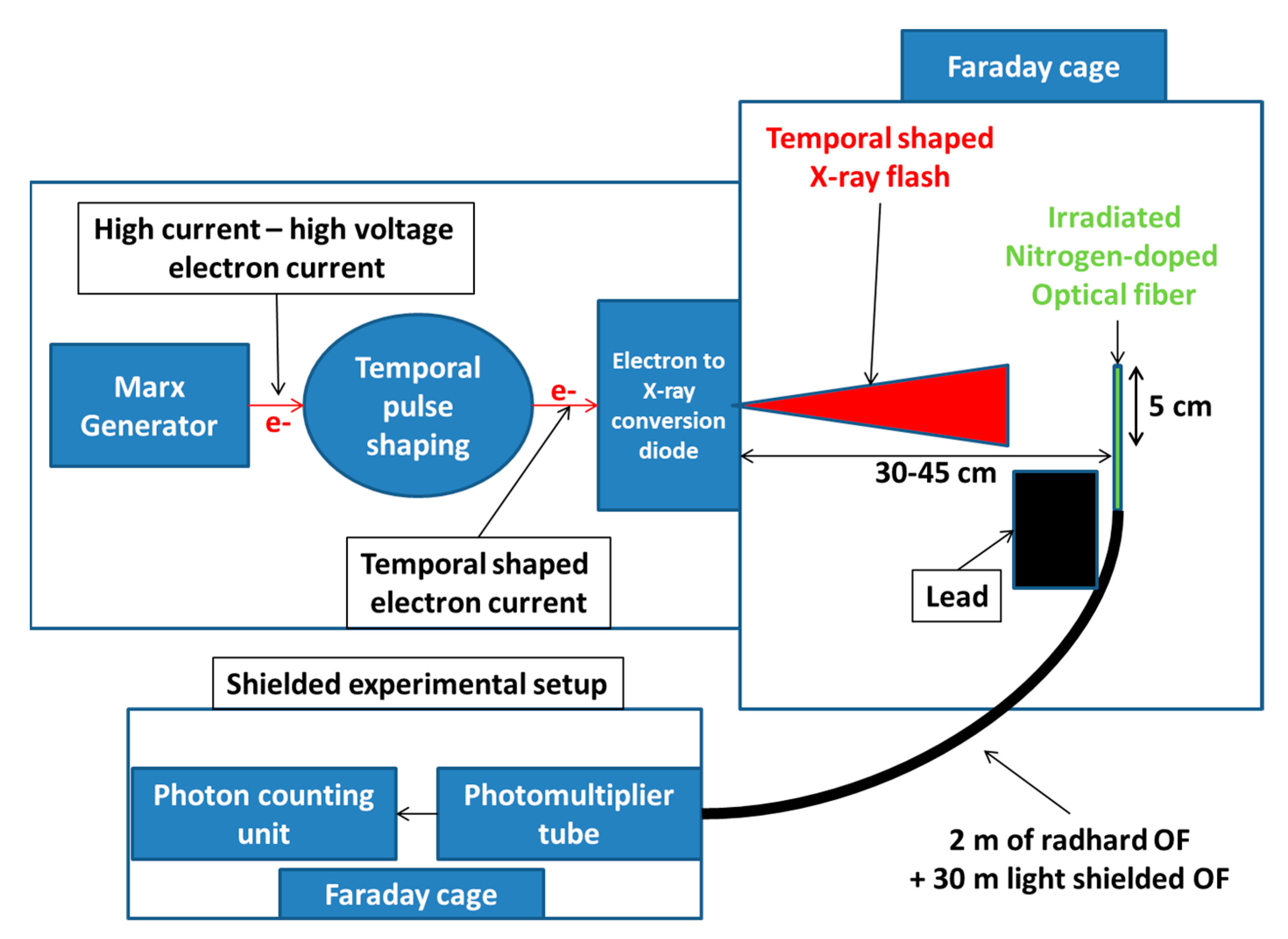
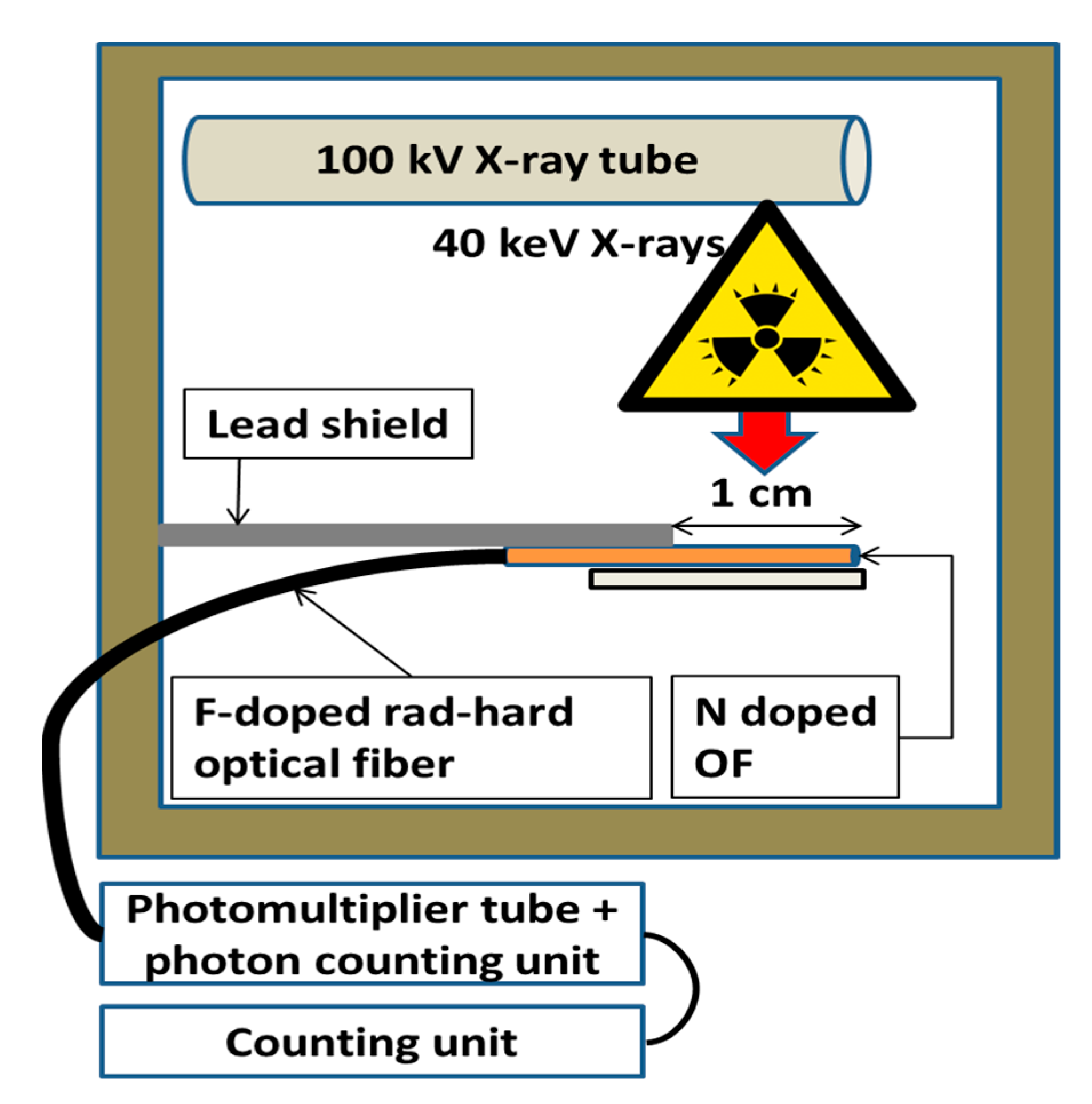
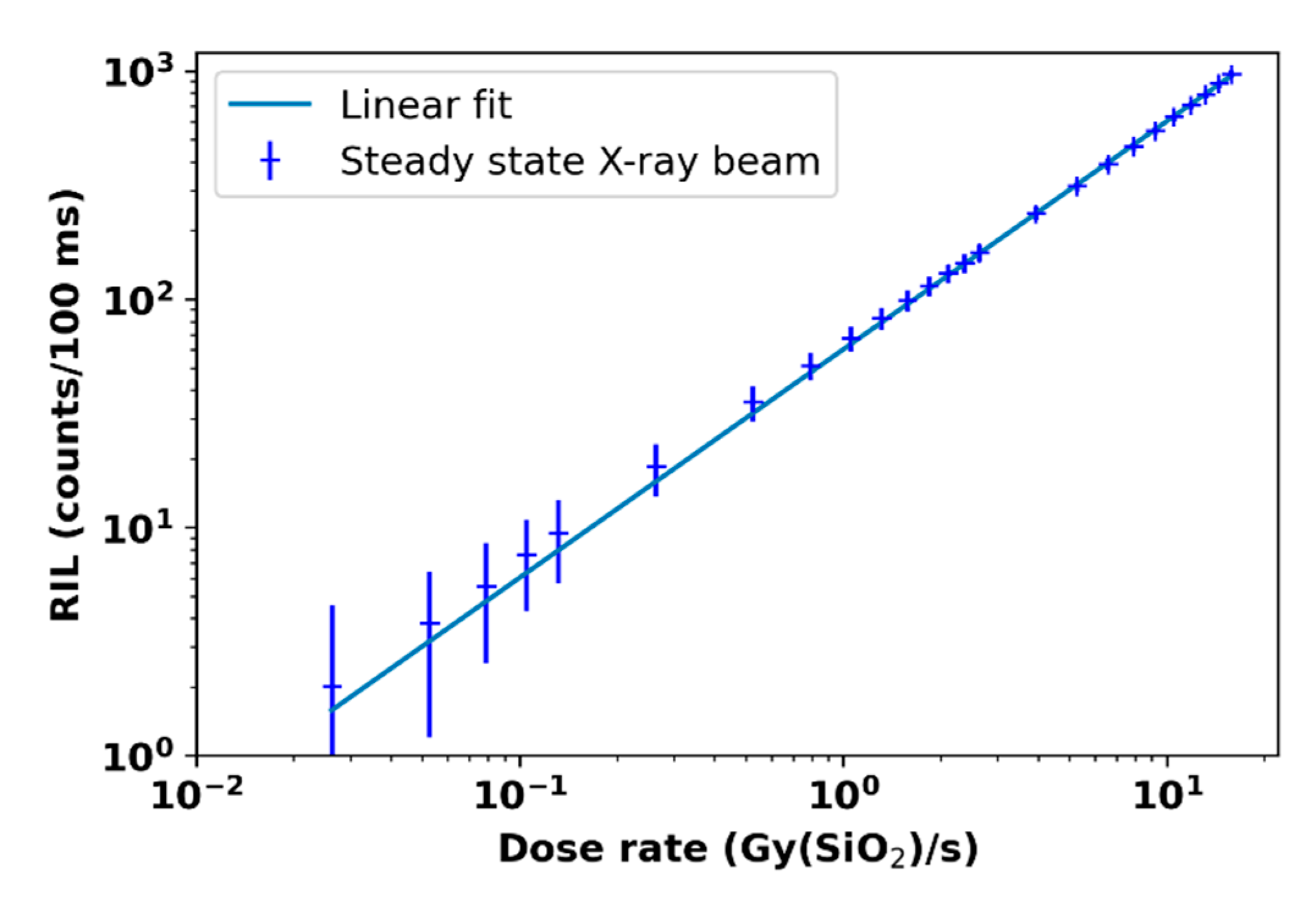
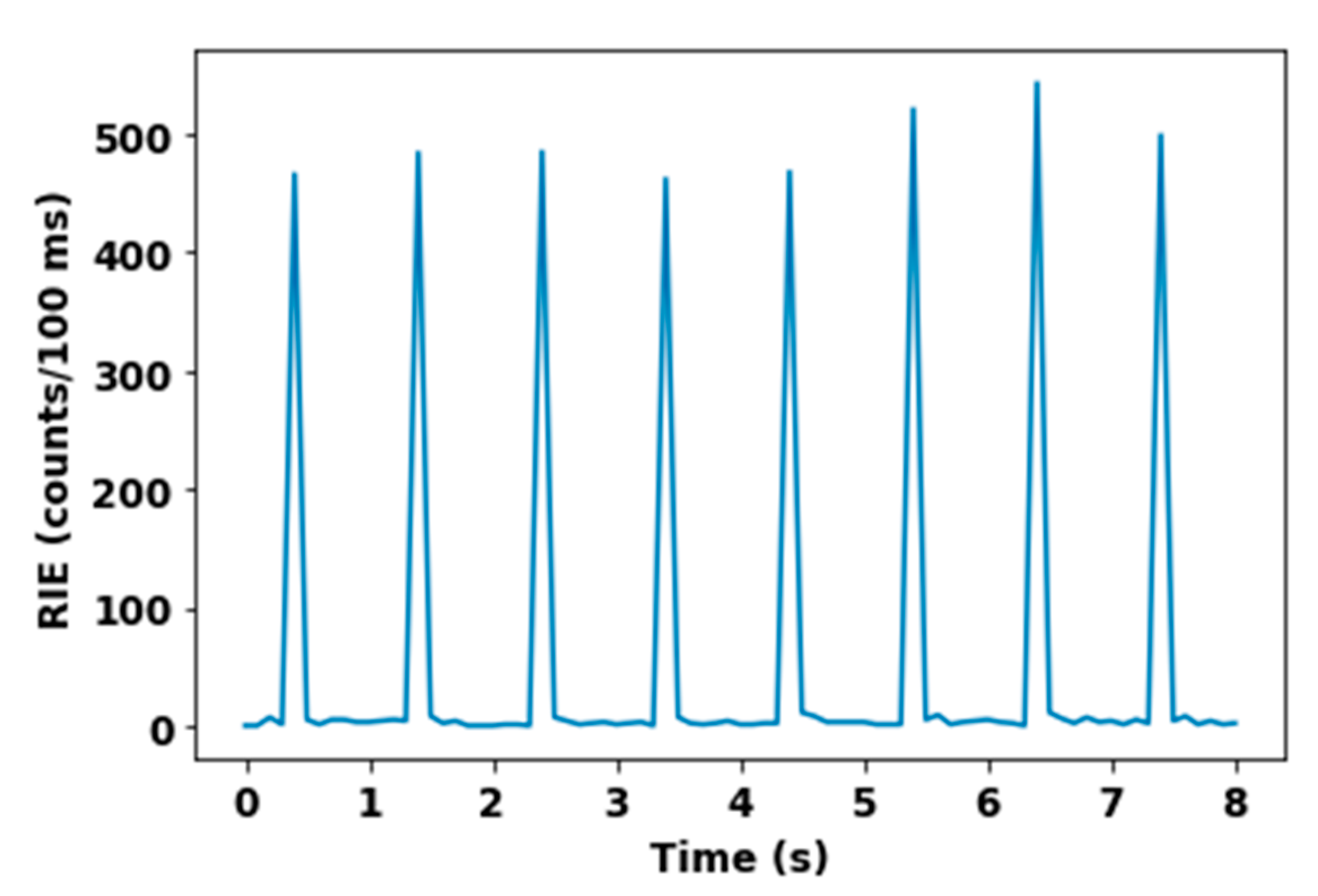

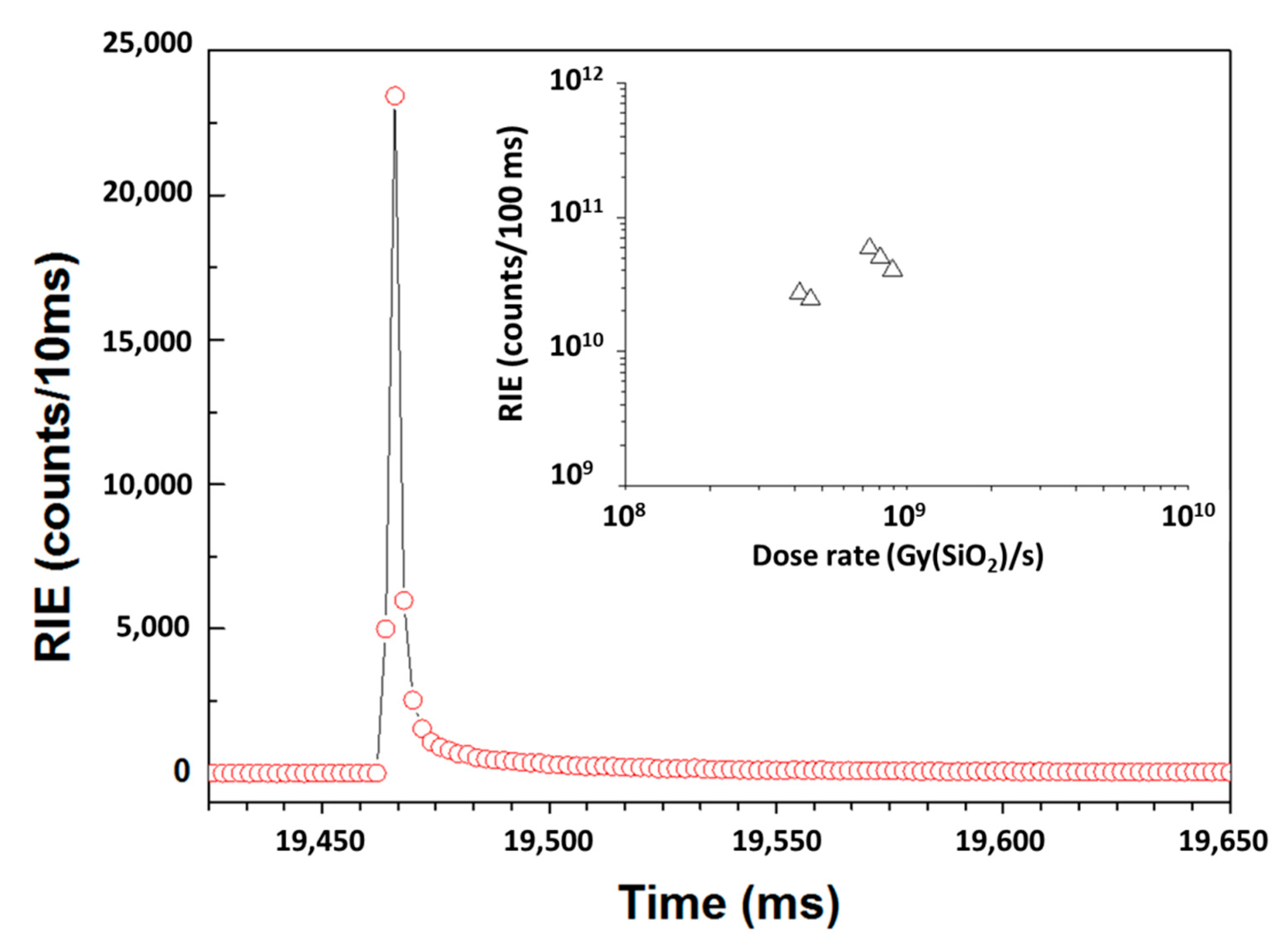

| Irradiation Type | A (Counts/Gy) |
|---|---|
| Steady-state X-ray | 602 |
| Steady-state X-ray + µs scale X-ray pulse | 663 |
| Steady-state X-ray + µs scale X-ray pulse + ns scale X-ray pulse | 558 |
Publisher’s Note: MDPI stays neutral with regard to jurisdictional claims in published maps and institutional affiliations. |
© 2022 by the authors. Licensee MDPI, Basel, Switzerland. This article is an open access article distributed under the terms and conditions of the Creative Commons Attribution (CC BY) license (https://creativecommons.org/licenses/by/4.0/).
Share and Cite
Vidalot, J.; Campanella, C.; Dachicourt, J.; Marcandella, C.; Duhamel, O.; Morana, A.; Poujols, D.; Assaillit, G.; Gaillardin, M.; Boukenter, A.; et al. Monitoring of Ultra-High Dose Rate Pulsed X-ray Facilities with Radioluminescent Nitrogen-Doped Optical Fiber. Sensors 2022, 22, 3192. https://doi.org/10.3390/s22093192
Vidalot J, Campanella C, Dachicourt J, Marcandella C, Duhamel O, Morana A, Poujols D, Assaillit G, Gaillardin M, Boukenter A, et al. Monitoring of Ultra-High Dose Rate Pulsed X-ray Facilities with Radioluminescent Nitrogen-Doped Optical Fiber. Sensors. 2022; 22(9):3192. https://doi.org/10.3390/s22093192
Chicago/Turabian StyleVidalot, Jeoffray, Cosimo Campanella, Julien Dachicourt, Claude Marcandella, Olivier Duhamel, Adriana Morana, David Poujols, Gilles Assaillit, Marc Gaillardin, Aziz Boukenter, and et al. 2022. "Monitoring of Ultra-High Dose Rate Pulsed X-ray Facilities with Radioluminescent Nitrogen-Doped Optical Fiber" Sensors 22, no. 9: 3192. https://doi.org/10.3390/s22093192
APA StyleVidalot, J., Campanella, C., Dachicourt, J., Marcandella, C., Duhamel, O., Morana, A., Poujols, D., Assaillit, G., Gaillardin, M., Boukenter, A., Ouerdane, Y., Girard, S., & Paillet, P. (2022). Monitoring of Ultra-High Dose Rate Pulsed X-ray Facilities with Radioluminescent Nitrogen-Doped Optical Fiber. Sensors, 22(9), 3192. https://doi.org/10.3390/s22093192







